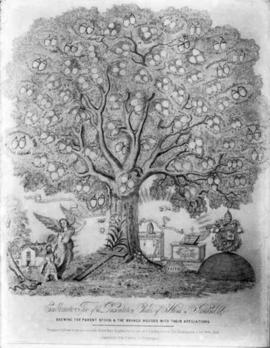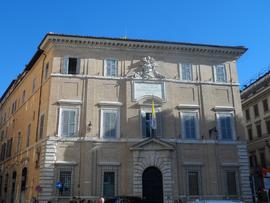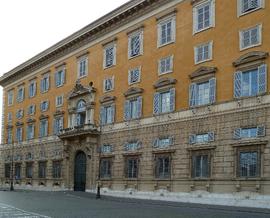- IE PVBM
- Corporate body
- 1600-2023
Showing 18 results
Authority recordSacra Congregatio de Propaganda Fide
- VA/SCPF
- Corporate body
- 1622-2023
The Sacred Congregation de Propaganda Fide, whose official title is "sacra congregatio christiano nomini propagando" is the department of the pontifical administration charged with the spread of Catholicism and with the regulation of ecclesiastical affairs in non-Catholic countries. The intrinsic importance of its duties and the extraordinary extent of its authority and of the territory under its jurisdiction have caused the cardinal prefect of Propaganda to be known as the "red pope".
Sacred Congregation of Religious
- CongR
- Corporate body
- 1587-2023
https://www.newadvent.org/cathen/13136a.htm
Sixtus V first erected by a Brief of 17 May, 1586, and afterwards, by the Constitution "Immensa", confirmed, a congregation "super consultationibus regularium" distinct from the congregation "super consultationibus episcoporum et aliorum prælatorum" mentioned in the same Constitution. In 1601 these two congregations were already combined in the Congregation of Bishops and Regulars, to which, in course of time, were united three other congregations whose functions were closely related. These three were: the Congregation on the State of Religious (super statu regularium), created by Innocent X on 15 August, 1652, for the reformation of regulars in Italy, and suppressed by Innocent XII on 4 August, 1698; the Congregation on Regular Discipline (super disciplina regulari), instituted by Innocent XII on 18 July, 1695, for the reformation of regulars not only in Italy but throughout the whole world; the Congregation on the State of the Regular Orders (super statu regularium ordinum), created by Pius IX on 17 June, 1847. The last-named and the one on regular discipline were suppressed by Pius X, by the Motu Proprio of 26 May, 1906, which united these congregations with that of Bishops and Regulars. The new Constitution of Pius X abolishes the Congregation of Regulars and Bishops and transfers that part of its business which concerns bishops to the Congregation of the Council, and that part of it which concerns regulars to a congregation (oongregatio negotiis religiosorum sodalium præposita) created by the new Constitution, and which by common usage sanctioned by the legend on the official seal of the congregation, has received the name of Congregatio of Religious.
This body has the usual organization of the Roman Congregations. It is formed of several cardinals, who are chosen by the pope, and one of whom is the prefect of the congregation; these cardinals are assisted by a secretary and a sub-secretary, who are the major officials of the congregation, and by several minor officials. In regard to the latter it is to be noted that, as the amount of its business necessitates a division of the congregation into three parts (as in the case of the Congregation of the Sacraments), the highest dignitaries among the minor officials are the three assistants who are placed over the three sections. One of these sections has to deal with matters relating to religious orders; another, with the business of religious congregations or associations of men, of whatever nature those associations may be; the third, with business relating to congregations of women. This congregation also has a college of consultors.
The Constitution of Pius X clearly defines the competency of this congregation, which is to pass judgment upon all matters relating to religious persons of either sex, whether bound by solemn or by simple vows, or to those persons who, although they be not religious in the canonical sense of the word, live as religious — such as the oblates of certain communities of men or of women, who, without being bound by vows, live a common life under an approved rule. The third orders, consisting of seculars, are also under this congregation. It decides in litigations between members of religious orders, or between religious and bishops, and it is the competent tribunal in eases which have to be dealt with in the way of discipline (in via disciplinari) where a religious appears either as plaintiff or as defendant. Hence it is to be inferred, and indeed is expressly stated in the Constitution, that causes which have to be dealt with in the judicial way must be referred to the Rota, the rights of the Holy Office being always safeguarded. Finally, all common law dispensations to regulars pertain to this congregation, excepting dispensation from the Eucharistic fast, which, as said above, pertains to the Congregation of the Sacraments. The Congregatio of Religious is alone competent to approve new religions institutes and their constitutions, as well as to modify institutes already approved, and these being matters of grave importance, the full congregation deals with them.
- RM/SCR
- Corporate body
- 1588-1969
The Sacred Congregation of Rites was a congregation of the Roman Curia, erected on 22 January 1588 by Pope Sixtus V by Immensa Aeterni Dei; it had its functions reassigned by Pope Paul VI on 8 May 1969.
The Congregation was charged with the supervision of the liturgy, the dispensation of the decrees of Canonical coronations, other various sacraments, and the process of canonization of saints.
Sisters of St. Joseph of Chambery Auth Rec
- SJCH
- Corporate body
- 1939- present
The Sisters of St. Joseph Chambery arrived in Wales from India in 1939. In 1958 they founded a house in Dublin at the invitation of Archbishop John Charles McQuaid.
This is the current site of St. Josephs hospital, Raheny. They sold this hospital in 1997, but still maintain a convent on the same site.
In 1977 they also bought a house for the purposes of supporting a novitiate, but sold this in 2005.
Supreme Sacred Congregation of the Roman and Universal Inquisition
- HI
- Corporate body
- 1542-2023
https://www.newadvent.org/cathen/08026a.htm
The great apostasy of the sixteenth century, the filtration of heresy into Catholic lands, and the progress of heterodox teachings everywhere, prompted Paul III to establish the "Sacra Congregatio Romanae et universalis Inquisitionis seu sancti officii" by the Constitution "Licet ab initio" of 21 July, 1542. This inquisitional tribunal, composed of six cardinals, was to be at once the final court of appeal for trials concerning faith, and the court of first instance for cases reserved to the pope. The succeeding popes — especially Pius IV (by the Constitutions "Pastoralis Oficii" of 14 October, 1562, "Romanus Pontifex" of 7 April, 1563, "Cum nos per" of 1564, "Cum inter crimina" of 27 August, 1562) and Pius V (by a Decree of 1566, the Constitution "Inter multiplices" of 21 December, 1566, and "Cum felicis record." of 1566) — made further provision for the procedure and competency of this court. By his Constitution "Immensa aeterni" of 23 January, 1587, Sixtus V became the real organizer, or rather reorganizer of this congregation.
The Holy Office is first among the Roman congregations. Its personnel includes judges, officials, consultors, and qualificators. The real judges are cardinals nominated by the pope, whose original number of six was raised by Pius IV to eight and by Sixtus V to thirteen. Their actual number depends on the reigning pope (Benedict XIV, Constitution "Sollicita et Provida", 1733). This congregation differs from the others, inasmuch as it has no cardinal-prefect: the pope always presides in person when momentous decisions are to be announced (coram Sanctissimo). The solemn plenary session on Thursdays is always preceded by a session of the cardinals on Wednesdays, at the church of Santa Maria sopra Minerva, and a meeting of the consultors on Mondays at the palace of the Holy Office. The highest official is the commissarius sancti oficii, a Dominican of the Lombard province, to whom two coadjutors are given from the same order. He acts as the proper judge throughout the whole case until the plenary session exclusive, thus conducting it up to the verdict. The assessor sancti officii, always one of the secular clergy, presides at the plenary sessions. The promotor fiscalis is at once prosecutor and fiscal representative, while the advocatus reorum undertakes the defence of the accused. The duty of the consultors is to afford the cardinals expert advice. They may come from the secular clergy or the religious orders, but the General of the Dominicans, the magister sacri palatii, and a third member of the same order are always ex-officio consultors (consultores nati). The qualificators are appointed for life, but give their opinions only when called upon. The Holy Office has jurisdiction over all Christians and, according to Pius IV, even over cardinals. In practice, however, the latter are held exempt. For its authority, see the aforesaid Constitution of Sixtus V "Immensa aeterni" (see ROMAN CONGREGATIONS).
The Passionist Congregation, St. Patrick's Province
- CP
- Corporate body
- 1856-2019
- Vtest
- Corporate body
- 1600-2020
- « Previous
- 1
- 2





